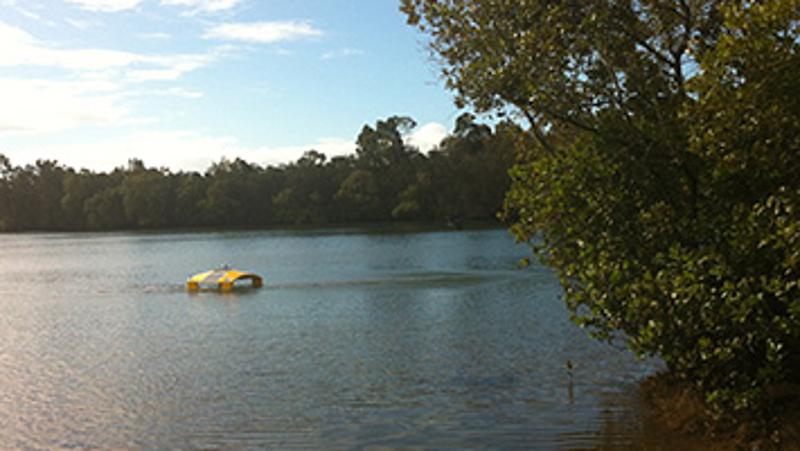
QUT has developed a flotilla of robot boats that monitor the effects of major weather events and provide early warning on potential environmental disasters.
QUT roboticist and Inference robotic boat creator Dr Matthew Dunbabin said, if deployed across our waterways, the autonomous vessels would vastly speed up the detection and responses to events, some of which could have serious environmental or public health implications.
"The Inference boats are designed to be our eyes, ears and nose on waterways, 24 hours a day - rain, hail or cyclone," he said.
Equipped with cameras and various air and water sensors, the Inference boats mark the first time in the world that researchers can collect real-time data about the impacts of weather events across waterways, helping authorities better plan for similar events in the future.
"As you can imagine, it's far too dangerous for a human to be out in a boat during a cyclone, collecting water samples to measure the amount of topsoil washing into a lake, for instance," said Dr Dunbabin from QUT's Institute for future Environments and Science and Engineering Faculty.
"Traditionally, scientists the world over have had to rely on simulated and sparse data to predict, respond to and plan for events like these - data that isn't always dead accurate.
"Inference is a game changer in terms of environmental research because it's designed to be there on the water 24/7, a permanent sensing presence capturing the hard data researchers and authorities need to make the best-informed decisions."
Dr Dunbabin said the robotic boat is designed to conduct a wide range of sampling and surveying tasks in inland waterways, including monitoring water quality; measuring gas emissions; inspecting jetties and dam walls; and mapping banks and lake-beds.
It can work autonomously or under remote control from anywhere in the world.
Dr Dunbabin has already been approached by international researchers seeking to use the boats for their ecological research.
Inference is just one of a suite of environmental monitoring robots being developed by QUT.
Dr Dunbabin has built a ground-based robot that uses sensors to map and count trees and other vegetation.
He is also developing another that can follow and record wildlife using stealth tactics such as only moving while there are other sounds to mask its own noise.
"I wanted to build something that would make Sir David Attenborough proud," he said.
"Studying the natural behaviour of animals in the wild is extremely difficult, particularly if they can smell, see or hear humans.
"To get the best footage of them in the wild requires both patience and stealth.
"A robot has the potential to achieve both. As long as it can mask its own sounds, it can creep much closer to the action for long periods of time, and record that natural behaviour for humans to study later or remotely."
QUT researchers are also using unmanned aircraft (UAs) to count koalas - a world first - and assess disease in crops and native plants. These projects are part of a comprehensive research program to develop UAs capable of monitoring wildlife, agriculture and air quality to enable better decision making in the management of our environment.
The public will be able to get up close and personal with QUT's environmental robots and more at Robotronica, the university's robotics spectacular.
Robotronica will include a wide range of international, national and home-grown robots, technologies and associated activities including:
•Neil Harbisson - British cyborg activist and first human to be officially recognised by governments as a cyborg
•Radius - a robot storyteller that educates and entertains children
•Shimon - Georgia Tech's jazz-improvising robot
•Pinokio - a robotic desk lamp that interacts with humans
•Naos - QUT's popular humanoid robots performing Tai Chi
•Baxter - QUT's research robot that plays an unbeatable game of Connect Four
•Sphero, mini quadcopter and prosthetic leg challenges - opportunities for the public to get hands-on
•robotics demonstrations, talks, workshops and other activities for all ages.
•a finale spectacular by QUT-sponsored DeepBlue and a cast of 50 custom-made QUT bots.
The free event takes place on Sunday August 23, as part of National Science Week.
For more information and the program of fascinating QUT and international robots visit the Robotronica website.
RELATED STORIES
Robotronica: come and meet the future
Do you see what I see? Meet the team giving robots an insight into being human.
Row, row, robo-boat: building the search-and-rescue vessels of the future
Media contact:
Kate Haggman, QUT Media, 07 3138 0358, kate.haggman@qut.edu.au
After hours Rose Trapnell, QUT Media team leader, 0407 585 901




